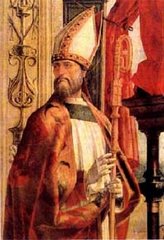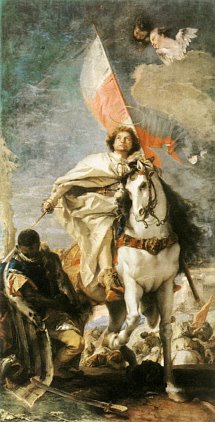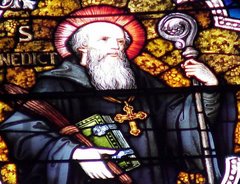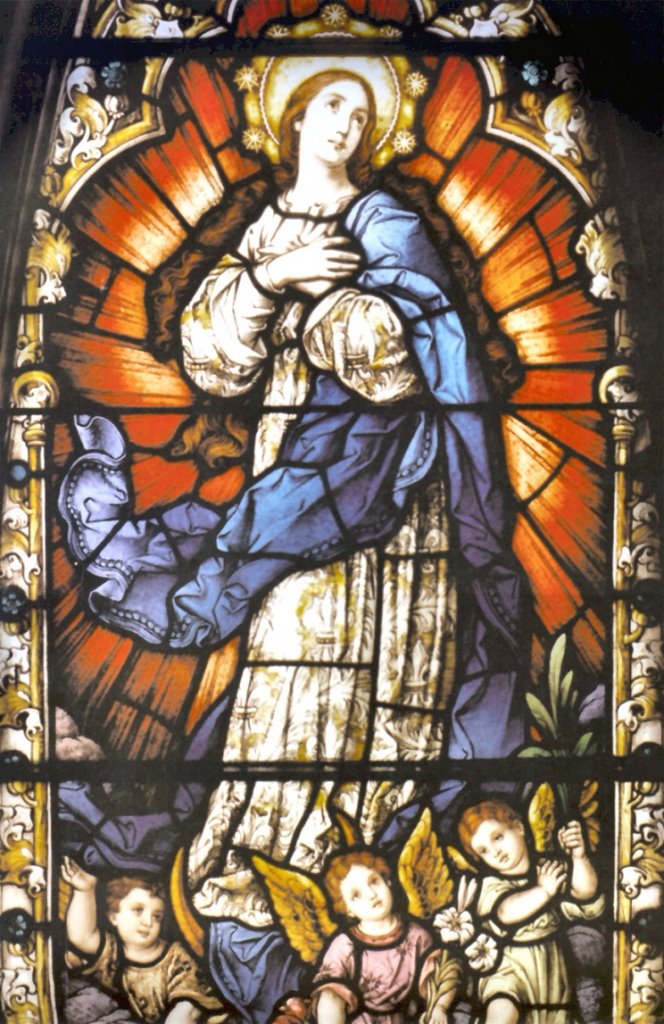We've introduced a few prominent Traditional Catholics, and will continue to do so, so to familiarize our readers with some of these key figures and what they did, and what it means. This is the history aspect, the history of Traditional Catholicism, ever since it became known as "traditional" so as to differentiate itself from the changes and modernizations and syncretism of Vatican II and its champions. And before actually telling the whole story we thought it best to introduce some of the characters and events involved in an effort to facilitate a fuller understanding of it, to avoid putting the cart before the horse. But in truth, the only real way to present the history is to tell what it was all about, this story actually begins with the Protestant Revolutions of the 16th century, but the immediate concern is Vatican II and fissure that resulted, is to describe what caused it. The Ottaviani Intervention has been described en pase, but to appreciate it fully, one must understand what was actually being proposed, and why those clerics opposed these changes, and what prompted their actions. This requires an understanding of modernity, the council, and its authors. What happened that there came a need for a movement for a return to or preservation of tradition? What was either incompatible with, or hostile to, that tradition? And so I've resolved to provide a brief introduction to the the thinking behind Vatican II as the Council Fathers and theologians saw it, and as historians have recorded it, which will soon be followed with the story of the Council and its opposition.
Ushering in a Reform
In order to be a witness to the truth, inflame the faith of Christians, and to minister to the welfare of the modern world, Pope John XXIII announced that he would summon a general Council. From the time of his election he had sought a new way of interacting with the world, as well as a renewed Church, a new direction, for the Church, and in particular to papal and Curial affairs. The "Pope"1 would assume a "pastoral" role in the Church, he would be humble and simple, and so the pontiff chose to be referred to as simply "John". He worked to change the atmosphere of veneration for the office he had assumed, and to limit the length of pontifical ceremonies and to reduce the forms and titles by which popes are addressed. The Church was seeming to be stuck in the Renaissance, there was too much undue pomp and celebration for the ceremonies of the Church, and it was thought that it was unappealing to Modern world, almost as though the Church were trapped in one point in time and could not move on.
The Council was to operate on the theme "aggiornamento", a "bringing up to date", or "modernization" of the Church, it was to be a going back to the simple and pure practices of the early Church. There was to be, as Cardinal Bea put it, "a reassessment of the doctrines of the Church", as well as internal ecclesiastical affairs, which meant that the Roman Curia would have to be reorganized, and a move away from the condemnatory character of the Office. The Sacraments would have to be reformed, especially the mass, liturgical ceremonies and the laws regarding education, the seminaries, and marriage. The practices of the Church had to be updated to accommodate the modern world in the spirit of the pure faith of the Early Church.
Ever since the Protestant Revolts in the 16th century the Church had been in a "Counter-Reformation" mode, leaving the Church with a suspicious view towards all things new. The Church had been on the defensive from the vicious attacks of dissenters, but that was four centuries [almost five] ago, and the world had moved on, and now it was time for the Church to move on, and to heal this schism. The Fathers at Vatican II saw the exclusiveness and rigidity of the Church, and failure to acknowledge its own many other indigences, as a barrier to this. Instead of condemning the modern world, it needed to dialogue with it. It needed to open up and work with it, instead of against it.
The Church could never be one as long as it remained at variance with its separated members, and like a good shepherd, it needed to go to them and seek to bring them back into the fold, it needed to accept that they had issues with the Church, and that these things needed to be resolved. The Church could never keep up with the world as long as it insisted that the modern world was evil, as long as it insisted on dwelling on its glory days, it needed to move into the modern world, and keep itself abreast of modern achievements if it was ever to accomplish its goal to unite all peoples in Christ.
To realize this, they vied for a redefinition, a reformulation, of the rights of laymen and bishops in the ecclesiastical hierarchy. They wanted a change in the apparel, the vestiture, of clerics and prelates. The time had come, it was perceived, when a re-evaluation of the mission of the Church was in order, as well as her responsibilities. It was thought that the Church was too pyramidal, too hierarchical. The Pope was seen as being idolized, and the power of the Church was too centralized, it seemed that the rights of the college of bishops were being depreciated, as each of the Apostles had equally received the charism to preach, to teach, and to baptize all men everywhere, including Peter whose position was, to serve his brethren, not to be an autocrat.
Over the Course of history, it was thought, the Western Church had several times had "adopted" the features of the political societies with which it was allied, as all as worldly institutions do, adopting the legal structure of the Roman Empire, in the Fourth and fifth centuries, and becoming a feudal power, in the Middle Ages, the monarchical power of the Pope had been overemphasized until that power was so centralized, as if he alone governed the Church, a centralization which had led to Josephism and Gallicanism as a reaction against this centralization of power within the Church, until gradually the rights of the bishops seemed to have been belittled, that the supremacy of the pope had been so over emphasized and there had been such a shift away from the original constitution of the Church on the College of the Apostles, that the Church was becoming totalitarian, and this, as they saw it, was not the will of Christ. They perceived that this would hamper the assimilation of dismembered Christians and the spirit of ecumenism in the Church. And so there was needed a restoration of the theology of the episcopate, the teaching of Vatican I was to be set in a pastoral and ecumenical formation. To fully explain "the bond joining the head of the Church and the apostolic college" in order to preclude the "danger of misunderstandings" among the Protestants and Orthodox. This restoration would curtail the notion of a pyramidal Church and emphasize the fact that bishops, laity, and religious, were all part of the people of God and that all the members of the Church were equal by virtue of their baptism.
When the First Vatican Council was called, the schema was not, rather, to "disassociate" the Pope from the bishops in defining his supremacy, this only occurred because of political upheaval which had brought the Council to an abrupt end, leaving its work incomplete. This abrupt end, as a result, caused the development of theologizations concerning the nature of the Church which was, in large part, one-sided and not true to the original vision of the Redeemer. In more recent times, it was thought, this notion of almost totalitarian rule had been exaggerated until the need to reform this imbalance had become incumbent upon the summoning of another Council.
To add to this "imbalance" in the structure of the Church, they reasoned, there was judgementalism and suspicion of new ideas and methods, following the condemnation of Modernism in 1907. Every thinker, theologian, and scholar, who did not conform to the Curia's "litmus tests", as it were, were suspected of heresy. It was like a new Spanish Inquisition, where the writings and teachings of Catholics in every field were subjected to a kind of inspection by the rigid and closed-minded clerics in the Curia. Because of this, the works of eminent orthodox historians and theologians such as Msgrs. Louis Duchesne, Le Chartier, and Pierre Batiffol were put on the Index Prohibitorum and "unfairly" charged of Modernism and of promoting relativism. And so even a minor slip in doctrine, dogmatic or moral, came to be the end of many an ecclesiastical career.
A contributing factor to this rigidity was that most of the Curials had never really been acquainted with an other religious experience except through textbook caricatured propositions in seminary. It was, the problem that is, the jealousness of doctrine, and almost fear for them, and for conformity in practice which would lead to a very suspicious and condemnatory perspective of the Modern world.
And thus this "backward" attitude, which resisted the new spirit of ecumenism and unity, prompted Roncalli, soon after his elevation, to bring the Church to terms with that new spirit and to bring the Church out of the Middle Ages and Counter-Reformation and into the Modern world. The Church needed to gather its members who were separated by historical prejudice and misunderstandings, such as the Greek Orthodox and the Protestants, The Church needed a Reform, it was time for the Church to be born anew and to re-assume its position and mission in the world, it was time for a "new springtime".
______________
Footnotes:
1. A reference to the office of "the Papacy", not rather, to the person, as the Papacy would thence forth be considered in a more pastoral light, as a father, and no longer as if he were a monarch.
Ushering in a Reform
In order to be a witness to the truth, inflame the faith of Christians, and to minister to the welfare of the modern world, Pope John XXIII announced that he would summon a general Council. From the time of his election he had sought a new way of interacting with the world, as well as a renewed Church, a new direction, for the Church, and in particular to papal and Curial affairs. The "Pope"1 would assume a "pastoral" role in the Church, he would be humble and simple, and so the pontiff chose to be referred to as simply "John". He worked to change the atmosphere of veneration for the office he had assumed, and to limit the length of pontifical ceremonies and to reduce the forms and titles by which popes are addressed. The Church was seeming to be stuck in the Renaissance, there was too much undue pomp and celebration for the ceremonies of the Church, and it was thought that it was unappealing to Modern world, almost as though the Church were trapped in one point in time and could not move on.
The Council was to operate on the theme "aggiornamento", a "bringing up to date", or "modernization" of the Church, it was to be a going back to the simple and pure practices of the early Church. There was to be, as Cardinal Bea put it, "a reassessment of the doctrines of the Church", as well as internal ecclesiastical affairs, which meant that the Roman Curia would have to be reorganized, and a move away from the condemnatory character of the Office. The Sacraments would have to be reformed, especially the mass, liturgical ceremonies and the laws regarding education, the seminaries, and marriage. The practices of the Church had to be updated to accommodate the modern world in the spirit of the pure faith of the Early Church.
Ever since the Protestant Revolts in the 16th century the Church had been in a "Counter-Reformation" mode, leaving the Church with a suspicious view towards all things new. The Church had been on the defensive from the vicious attacks of dissenters, but that was four centuries [almost five] ago, and the world had moved on, and now it was time for the Church to move on, and to heal this schism. The Fathers at Vatican II saw the exclusiveness and rigidity of the Church, and failure to acknowledge its own many other indigences, as a barrier to this. Instead of condemning the modern world, it needed to dialogue with it. It needed to open up and work with it, instead of against it.
The Church could never be one as long as it remained at variance with its separated members, and like a good shepherd, it needed to go to them and seek to bring them back into the fold, it needed to accept that they had issues with the Church, and that these things needed to be resolved. The Church could never keep up with the world as long as it insisted that the modern world was evil, as long as it insisted on dwelling on its glory days, it needed to move into the modern world, and keep itself abreast of modern achievements if it was ever to accomplish its goal to unite all peoples in Christ.
To realize this, they vied for a redefinition, a reformulation, of the rights of laymen and bishops in the ecclesiastical hierarchy. They wanted a change in the apparel, the vestiture, of clerics and prelates. The time had come, it was perceived, when a re-evaluation of the mission of the Church was in order, as well as her responsibilities. It was thought that the Church was too pyramidal, too hierarchical. The Pope was seen as being idolized, and the power of the Church was too centralized, it seemed that the rights of the college of bishops were being depreciated, as each of the Apostles had equally received the charism to preach, to teach, and to baptize all men everywhere, including Peter whose position was, to serve his brethren, not to be an autocrat.
Over the Course of history, it was thought, the Western Church had several times had "adopted" the features of the political societies with which it was allied, as all as worldly institutions do, adopting the legal structure of the Roman Empire, in the Fourth and fifth centuries, and becoming a feudal power, in the Middle Ages, the monarchical power of the Pope had been overemphasized until that power was so centralized, as if he alone governed the Church, a centralization which had led to Josephism and Gallicanism as a reaction against this centralization of power within the Church, until gradually the rights of the bishops seemed to have been belittled, that the supremacy of the pope had been so over emphasized and there had been such a shift away from the original constitution of the Church on the College of the Apostles, that the Church was becoming totalitarian, and this, as they saw it, was not the will of Christ. They perceived that this would hamper the assimilation of dismembered Christians and the spirit of ecumenism in the Church. And so there was needed a restoration of the theology of the episcopate, the teaching of Vatican I was to be set in a pastoral and ecumenical formation. To fully explain "the bond joining the head of the Church and the apostolic college" in order to preclude the "danger of misunderstandings" among the Protestants and Orthodox. This restoration would curtail the notion of a pyramidal Church and emphasize the fact that bishops, laity, and religious, were all part of the people of God and that all the members of the Church were equal by virtue of their baptism.
When the First Vatican Council was called, the schema was not, rather, to "disassociate" the Pope from the bishops in defining his supremacy, this only occurred because of political upheaval which had brought the Council to an abrupt end, leaving its work incomplete. This abrupt end, as a result, caused the development of theologizations concerning the nature of the Church which was, in large part, one-sided and not true to the original vision of the Redeemer. In more recent times, it was thought, this notion of almost totalitarian rule had been exaggerated until the need to reform this imbalance had become incumbent upon the summoning of another Council.
To add to this "imbalance" in the structure of the Church, they reasoned, there was judgementalism and suspicion of new ideas and methods, following the condemnation of Modernism in 1907. Every thinker, theologian, and scholar, who did not conform to the Curia's "litmus tests", as it were, were suspected of heresy. It was like a new Spanish Inquisition, where the writings and teachings of Catholics in every field were subjected to a kind of inspection by the rigid and closed-minded clerics in the Curia. Because of this, the works of eminent orthodox historians and theologians such as Msgrs. Louis Duchesne, Le Chartier, and Pierre Batiffol were put on the Index Prohibitorum and "unfairly" charged of Modernism and of promoting relativism. And so even a minor slip in doctrine, dogmatic or moral, came to be the end of many an ecclesiastical career.
A contributing factor to this rigidity was that most of the Curials had never really been acquainted with an other religious experience except through textbook caricatured propositions in seminary. It was, the problem that is, the jealousness of doctrine, and almost fear for them, and for conformity in practice which would lead to a very suspicious and condemnatory perspective of the Modern world.
And thus this "backward" attitude, which resisted the new spirit of ecumenism and unity, prompted Roncalli, soon after his elevation, to bring the Church to terms with that new spirit and to bring the Church out of the Middle Ages and Counter-Reformation and into the Modern world. The Church needed to gather its members who were separated by historical prejudice and misunderstandings, such as the Greek Orthodox and the Protestants, The Church needed a Reform, it was time for the Church to be born anew and to re-assume its position and mission in the world, it was time for a "new springtime".
______________
Footnotes:
1. A reference to the office of "the Papacy", not rather, to the person, as the Papacy would thence forth be considered in a more pastoral light, as a father, and no longer as if he were a monarch.

















No comments:
Post a Comment